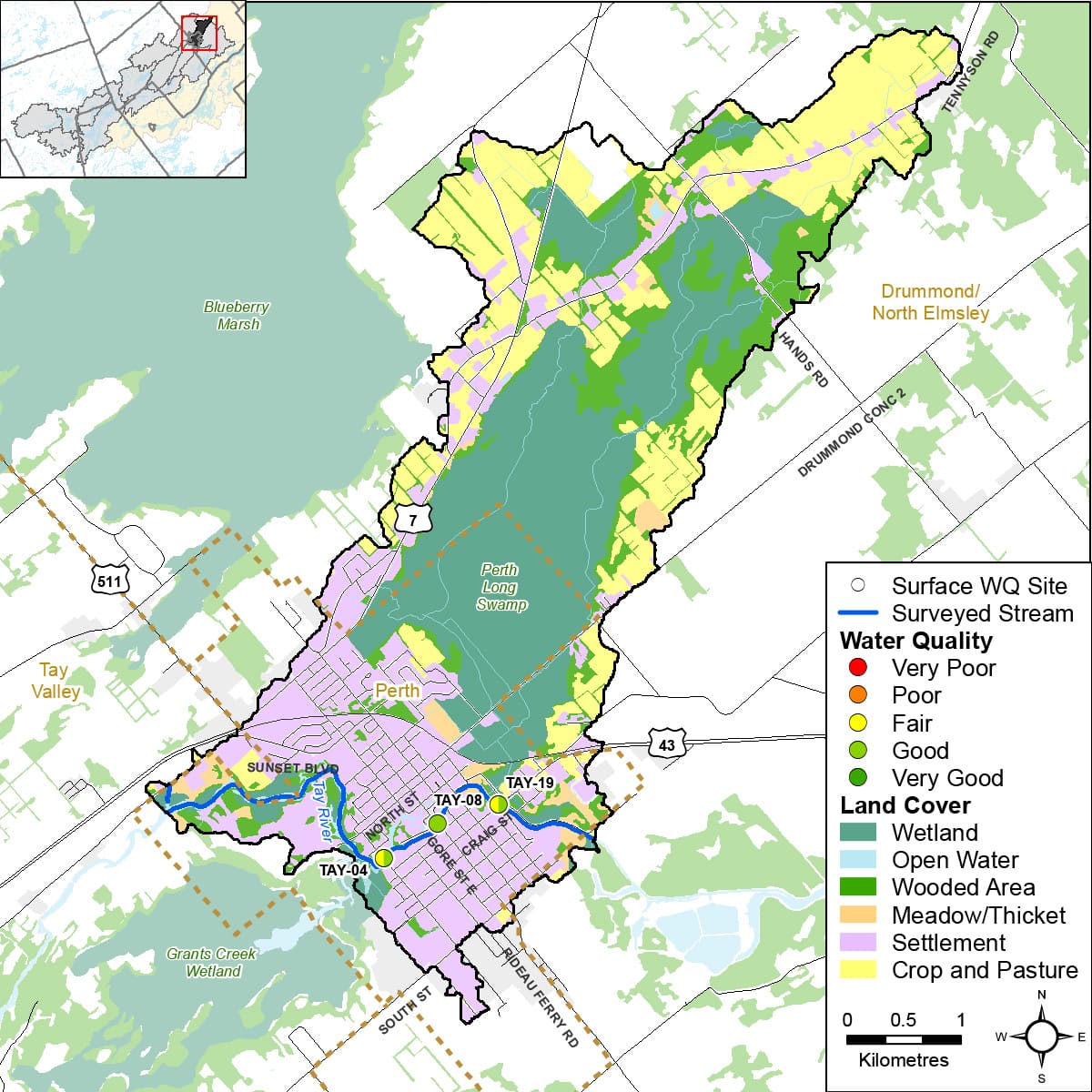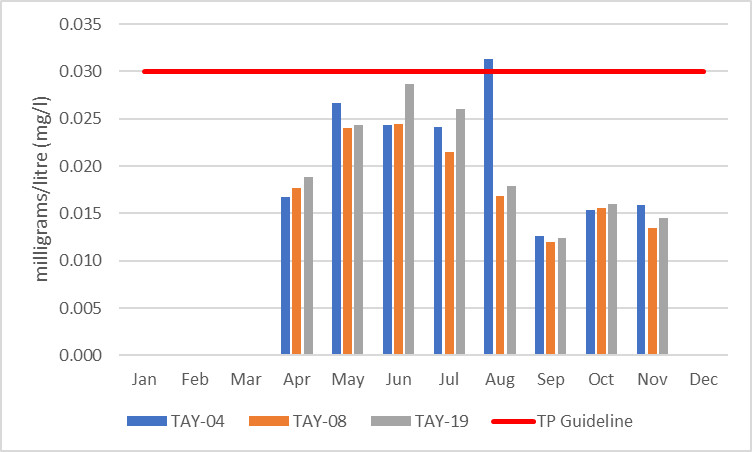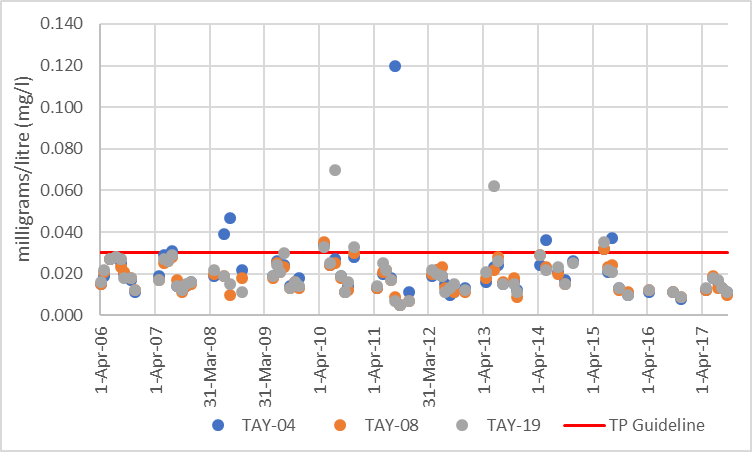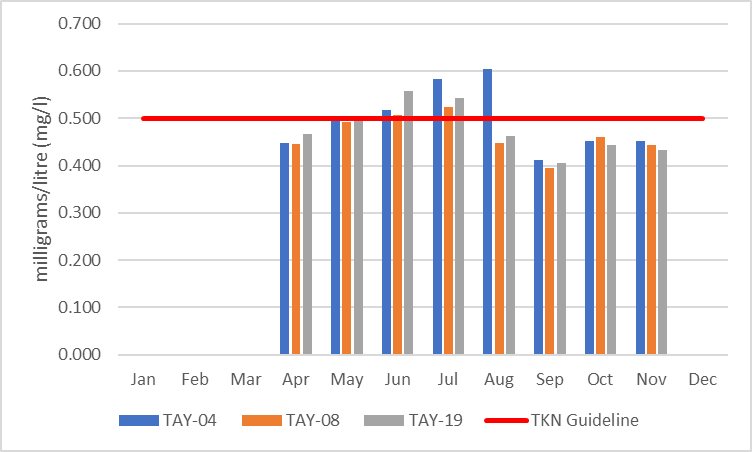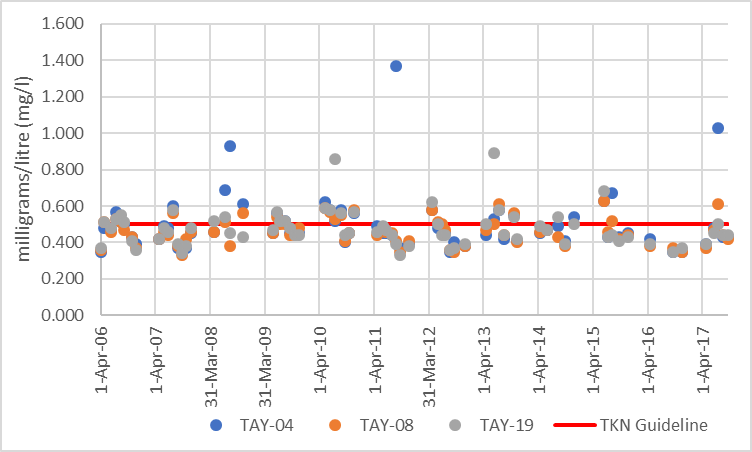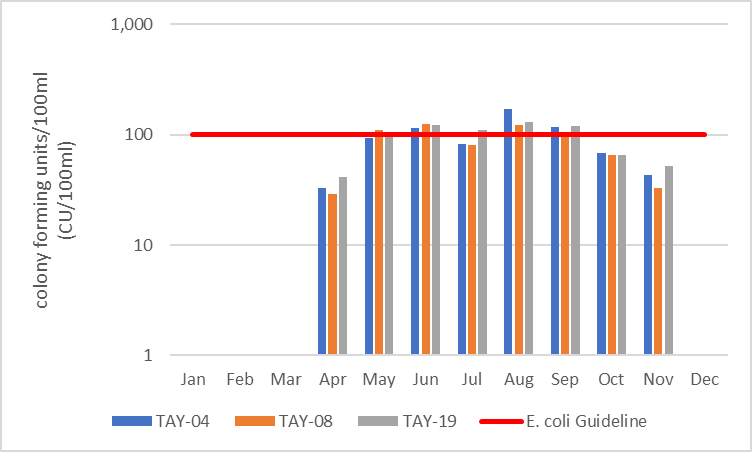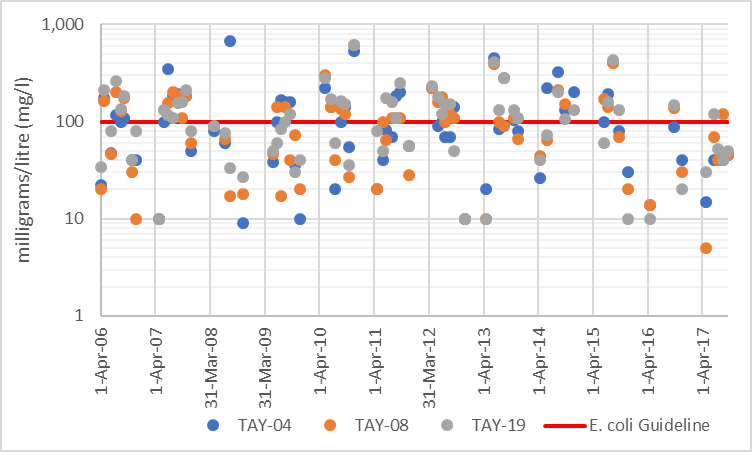2.0 Perth Catchment: Water Quality Conditions
Surface water quality conditions in the Perth catchment are monitored by the Rideau Valley Conservation Authority (RVCA) Baseline Water Quality Monitoring Program. The baseline water quality program focuses on streams; data is collected for 22 parameters including nutrients (total phosphorus and total Kjeldahl nitrogen), E. coli, metals (like aluminum and copper) and additional chemical/physical parameters (such as alkalinity, chlorides, pH and total suspended solids). Figure 2 shows the locations of monitoring sites in the catchment.
2.1 Tay River: Water Quality Rating
Three locations are monitored for water quality within the urban portion of the Town of Perth (Figure 2). The RVCA's water quality rating ranges from "Fair" to "Good" (Table 1) along the Tay River in the catchment, as determined by the Canadian Council of Ministers of the Environment (CCME) Water Quality Index.
A "Fair" rating indicates that water quality is usually protected but is occasionally threatened or impaired; conditions sometimes depart from natural or desirable levels. "Good" indicates that only a minor degree of threat or impairment is observed and conditions rarely depart from natural or desirable levels. Each parameter is evaluated against established guidelines to determine water quality conditions. Those parameters that frequently exceed guidelines are presented below.
Data has been analyzed over the 2006-2017 period for general trends and conditions. Table 1 shows the overall rating for the monitored surface water quality sites within the catchment and Table 2 outlines the Water Quality Index (WQI) scores and their corresponding ratings. The scores at these sites are largely influenced by few high nutrient concentrations and bacterial counts. For more information on the CCME WQI, please see the Tay River Subwatershed Report.
| Site | Location | 2006-2008 | 2009-2011 | 2012-2014 | 2015-2017 |
|---|---|---|---|---|---|
| TAY-04 | Tay River at Rogers Rd. | Good (84) | Fair (69) | Good (84) | Good (90) |
| TAY-08 | Tay River at Gore St. | Good (91) | Good (80) | Good (84) | Good (90) |
| TAY-19 | Tay River at Craig St. | Good (81) | Fair (77) | Good (87) | Good (87) |
| Rating | Index Score |
|---|---|
| Very Good (Excellent) | 95-100 |
| Good | 80-94 |
| Fair | 65-79 |
| Poor (Marginal) | 45-64 |
| Very Poor (Poor) | 0-44 |
2.1.1 Tay River: Nutrients
Total phosphorus (TP) is used as a primary indicator of excessive nutrient loading and may contribute to abundant aquatic vegetation growth and depleted dissolved oxygen levels. The Provincial Water Quality Objective (PWQO) is used as the TP Guideline and states that in streams concentrations greater than 0.030 mg/l indicate an excessive amount of TP.
Total Kjeldahl nitrogen (TKN) is used as secondary indicators of nutrient loading. RVCA uses a guideline of 0.500 mg/l to assess TKN[1] .
Tables 3 and 4 summarize average nutrient concentrations at monitored sites within the Perth catchment and show the proportion of results that meet the guidelines.
| Total Phosphorus 2006-2017 | |||
|---|---|---|---|
| Site | Average (mg/l) | Below Guideline | No. Samples |
| TAY-04 | 0.021 | 88% | 72 |
| TAY-08 | 0.018 | 97% | 71 |
| TAY-19 | 0.020 | 92% | 72 |
| Total Kjeldahl Nitrogen 2006-2017 | |||
|---|---|---|---|
| Site | Average (mg/l) | Below Guideline | No. Samples |
| TAY-04 | 0.499 | 65% | 72 |
| TAY-08 | 0.462 | 69% | 71 |
| TAY-19 | 0.476 | 65% | 72 |
Monitoring Site TAY-04
Site TAY-04 is the most upstream site within the Town of Perth. The majority (88 percent) of samples at this site were below the TP guideline from 2006-2017 (Figures 3 and 4). The average TP concentration in the at this site was 0.021 mg/l (Table 3), the monthly average concentrations appear higher in the spring and early summer and decline into the fall (Figure 3). In August the average concentrations exceeded the guideline (Figure 3), however this seems to be due to the influence of a single elevated sample in August 2011 (Figure 4) and does not reflect typical concentrations. Overall a decrease was observed in TP concentrations over the 2006-2017 period2.
TKN concentrations show that the bulk of results (65 percent) were also below the guideline (Figure 6, Table 4). The average concentration over the 2006-2017 period was 0.499 mg/l (Table 4); monthly averages increased from April to August, with lower concentrations observed in the fall months (Figure 5). There was no significant trend found in TKN results at this site.
Monitoring Site TAY-08
Site TAY-08 is downstream of TAY-04 and within the urban portion of Perth. TP results were low, the average concentrations was 0.018 and 97 percent of samples were below the guideline (Table 3, Figure 4). Monthly TP concentrations followed a similar pattern to upstream site TAY-04, with the highest concentrations observed from May-July, average TP concentrations did not exceed the guideline in any of the monitored months (Figure 3). A declining trend in TP concentrations was also observed in the data from this site.
The majority of TKN results were below the guideline (Figure 5 and 6), 69 percent of samples were below 0.500 mg/l (TKN Guideline) with an average concentration of 0.462 mg/l (Table 4). Average monthly concentrations were comparable and also followed a similar pattern to TAY-04 (Figure 5). No significant trend was observed in the 2006-2017 TKN dataset.
Monitoring Site TAY-19
Site TAY-19 is the most downstream site within the Town of Perth, TP concentrations are comparable to both upstream sites (TAY-04 and TAY-08) previously discussed (Figure 3). Ninety-two percent of samples at this site were below the TP guideline from 2006-2017 (Figures 3 and 4), and the average TP concentration in the at this site was 0.020 mg/l (Table 3). The monthly average concentrations were also the highest from May to July and no average monthly concentration exceeded the guideline (Figure 3). A decrease was observed in TP concentrations over the 2006-2017 period.
TKN concentrations show that the bulk of results (65 percent) were also below the guideline (Figure 6, Table 4). The average concentration over the 2006-2017 period was 0.476 mg/l (Table 4). Average monthly concentrations (Figure 5) show a similar pattern to upstream sites (TAY-04 and TAY-08) with generally comparable concentrations. No trend in TKN concentrations was observed at this site.
Summary of Tay River Nutrients
The data collected in this catchment provides evidence that nutrient enrichment is not a significant concern in this reach of the Tay River. Overall, the consistency in TP and TKN concentrations from TAY-04 to TAY-19 support that there is little nutrient enrichment as the Tay River flows through the Town of Perth. A declining trend in TP concentrations was also noted at all sites. This provides support that cumulative changes throughout the catchment has reduced nutrient concentrations. This should be taken as a positive sign as high nutrient concentrations can help stimulate the growth of algae blooms and other aquatic vegetation in a waterbody and deplete oxygen levels as the vegetation dies off. It is important to continue using best management practices that help prevent nutrient pollution in the Tay River; measures such as maintaining/upgrading municipal infrastructure (sanitary/stormwater sewers and water works), enhancing shoreline buffers, minimizing/discontinuing the use of fertilizers and restricting livestock access in upstream agricultural areas of the catchment.
2.1.2 Tay River E. coli
Escherichia coli (E. coli) is used as an indicator of bacterial pollution from human or animal waste; in elevated concentrations it can pose a risk to human health. The PWQO of 100 colony forming units/100 milliliters (CFU/100 ml) is used. E. coli counts greater than this guideline indicate that bacterial contamination may be a problem within a waterbody.
Table 5 summarizes the geometric mean[3] for the monitored sites within the Town of Perth catchment and shows the proportion of samples that meet the E. coli guideline of 100 CFU/100 ml. The results of the geometric mean with respect to the guideline, are shown in Figures 7 and 8 respectively.
| E. coli 2006-2017 | |||
|---|---|---|---|
| Site | Geometric Mean (CFU/100ml) | Below Guideline | No. Samples |
| TAY-04 | 80 | 50% | 71 |
| TAY-08 | 72 | 51% | 72 |
| TAY-11 | 86 | 46% | 71 |
Monitoring Site TAY-04
E. coli counts at site TAY-04 indicate that counts regularly exceed the guideline of 100 CFU/100ml. Fifty percent of samples were below the guideline (Figures 7-8) and the count at the geometric mean was only 80 CFU/100ml (Table 5). Monthly E. coli counts showed that the geometric mean was highest during the warmer months and counts exceeded the guideline in June, August and September. Warm water temperatures are more favourable for bacterial growth. (Figure 7). No trend was noted in E. coli counts over the 2006-2017 period.
Monitoring Site TAY-08
Elevated E. coli counts at site downstream site TAY-08 were also common. Fifty-one percent of samples were below the guideline (Figure 8) from 2006-2017 and the count at the geometric mean was 72 CFU/100ml (Table 5). The highest counts were recorded in June and August (Figure 7). As with site TAY-09 there was no significant trend in E. coli data over the 2006-2017 period.
Monitoring Site TAY-19
E. coli counts at site TAY-19 was comparable to those upstream (TAY-04 and TAY-08). Forty-six percent of samples were below the guideline, with count of 86 CFU/100ml at the geometric mean (Table 5, Figure 8). Monthly E. coli counts were above the guideline from June-September (Figure 7). As with upstream sites, no trend was noted in E. coli counts over the 2006-2017 period.
Summary of Tay River Bacterial Contamination
Given the frequency of samples that exceed the guidelines and counts approaching the guideline at all three sites, there is evidence that at times bacterial pollution is a concern within this reach of the Tay River. The data is comparable between all three sites thus does not provide sufficient information to; pinpoint possible sources of pollution; Minimizing runoff from infrastructure and roadways should be a priority in this catchment, such as ongoing efforts to improve storm water management within developed areas. Best management practices such as maintaining/enhancing municipal infrastructure, enhancing shoreline buffers, limiting livestock access and minimizing runoff in both agricultural and developed areas can help to protect this reach of the Tay River into the future.
1 No Ontario guideline for TKN is presently available; however, waters not influenced by excessive organic inputs typically range from 0.100 to 0.500 mg/l, Environment Canada (1979) Water Quality Sourcebook, A Guide to Water Quality Parameters, Inland Waters Directorate, Water Quality Branch, Ottawa, Canada.
2 Trends in the data were assessed using the Mann-Kendall trend test and Sens slope statistic.
3 Type of mean or average, which indicates the central tendency or typical value of a set of numbers by using the product of their values (as opposed to the arithmetic mean which uses their sum). It is often used to summarize a variable that varies over several orders of magnitude, such as E. coli counts.
